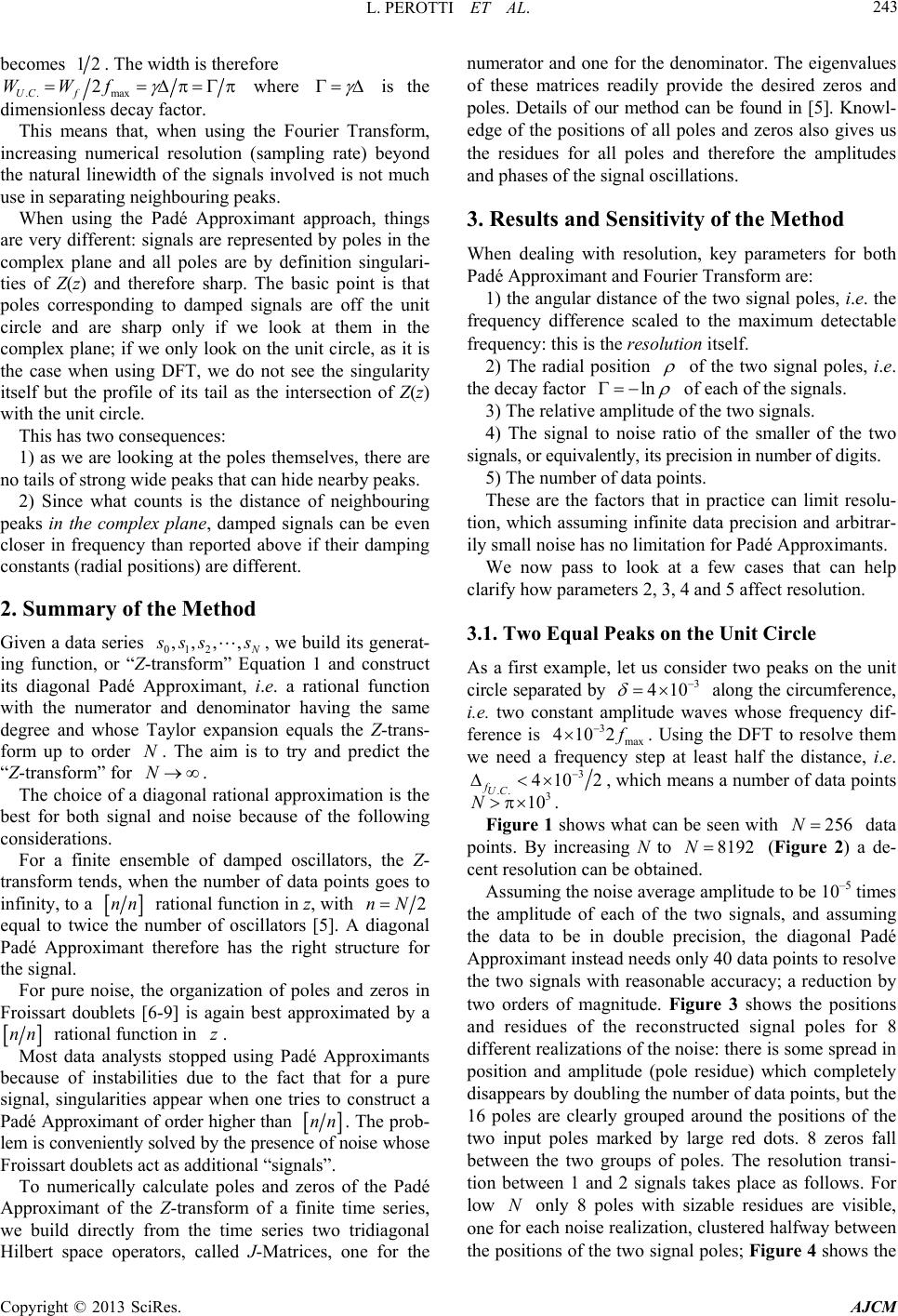
L. PEROTTI ET AL. 243
becomes 12. The width is therefore
.. max
2
UC f
WWf
where
is the
dimensionless decay factor.
This means that, when using the Fourier Transform,
increasing numerical resolution (sampling rate) beyond
the natural linewidth of the signals involved is not much
use in separating neighbouring peaks.
When using the Padé Approximant approach, things
are very different: signals are represented by poles in the
complex plane and all poles are by definition singulari-
ties of Z(z) and therefore sharp. The basic point is that
poles corresponding to damped signals are off the unit
circle and are sharp only if we look at them in the
complex plane; if we only loo k on the unit circle, as it is
the case when using DFT, we do not see the singularity
itself but the profile of its tail as the intersection of Z(z)
with the unit circle.
This has two consequences:
1) as we are looking at the poles themselves, there are
no tails of strong wide peaks that can hide nearby peaks.
2) Since what counts is the distance of neighbouring
peaks in the comp lex plane, damped signals can be even
closer in frequency than reported above if their damping
constants (radial positions) are different.
2. Summary of the Method
Given a data series 012
,,, ,
ss s
N
N
, we build its generat-
ing function, or “Z-transform” Equation 1 and construct
its diagonal Padé Approximant, i.e. a rational function
with the numerator and denominator having the same
degree and whose Taylor expansion equals the Z-trans-
form up to order . The aim is to try and predict the
“Z-transform” for .
The choice of a diagonal rational approximation is the
best for both signal and noise because of the following
considerations.
For a finite ensemble of damped oscillators, the Z-
transform tends, when the number of data points goes to
infinity, to a
nn rational function in z, with 2nN
equal to twice the number of oscillators [5]. A diagonal
Padé Approximant therefore has the right structure for
the signal.
For pure noise, the organization of poles and zeros in
Froissart doublets [6-9] is again best approximated by a
nn rational function in
.
Most data analysts stopped using Padé Approximants
because of instabilities due to the fact that for a pure
signal, singularities appear when one tries to construct a
Padé Approximant of order higher than
nn. The prob-
lem is conveniently solved by the presence of noise who s e
Froissart doublets act as additional “signals”.
To numerically calculate poles and zeros of the Padé
Approximant of the Z-transform of a finite time series,
we build directly from the time series two tridiagonal
Hilbert space operators, called J-Matrices, one for the
numerator and one for the denominator. The eigenvalues
of these matrices readily provide the desired zeros and
poles. Details of our method can be found in [5]. Knowl-
edge of the positions of all poles and zeros also gives us
the residues for all poles and therefore the amplitudes
and phases of the signal oscillations.
3. Results and Sensitivity of the Method
When dealing with resolution, key parameters for both
Padé Approximant and Fourier Transform are:
1) the angular distance of the two signal poles, i.e. the
frequency difference scaled to the maximum detectable
frequency: this is the resolution itself.
2) The radial position
of the two signal poles, i.e.
the decay factor ln
of each of the signals.
3) The relative amplitude of the two signals.
4) The signal to noise ratio of the smaller of the two
signals, or equivalently , its precision in num ber of digits.
5) The number of data poin ts.
These are the factors that in practice can limit resolu-
tion, which assuming infinite data precision and arbitrar-
ily small noise has no limitatio n for Padé Approximants.
We now pass to look at a few cases that can help
clarify how parameters 2, 3, 4 and 5 affect resolution.
3.1. Two Equal Peaks on the Unit Circle
As a first example, let us consider two peaks on the unit
circle separated by along the circumference,
i.e. two constant amplitude waves whose frequency dif-
ference is
3
410
max
2
3
410
. Using the DFT to resolve them
we need a frequency step at least half the distance, i.e.
3
.. 410 2
fUC
3
10N
, which means a number of data poin ts
.
Figure 1 shows what can be seen with 256N
data
points. By increasing N to (Figure 2) a de-
cent resolution can be obtained. 8192N
Assuming the noise average amplitude to be 10–5 times
the amplitude of each of the two signals, and assuming
the data to be in double precision, the diagonal Padé
Approximant instead need s only 40 data points to resolve
the two signals with reasonable accuracy; a reduction by
two orders of magnitude. Figure 3 shows the positions
and residues of the reconstructed signal poles for 8
different realizations of the noise: there is some spread in
position and amplitude (pole residue) which completely
disappears by doublin g th e nu mber of d ata p oints, bu t the
16 poles are clearly grouped around the positions of the
two input poles marked by large red dots. 8 zeros fall
between the two groups of poles. The resolution transi-
tion between 1 and 2 signals takes place as follows. For
low only 8 poles with sizable residues are visible,
one for each noise realization, clustered halfway between
the positions of the two signal p oles; Figure 4 shows th e
N
Copyright © 2013 SciRes. AJCM